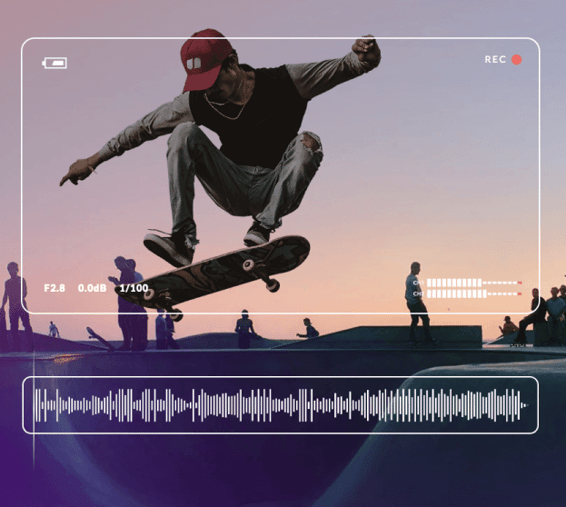Welcome to Outstanding
Royalty Free Cinematic Music






Listen to Our Best Royalty Free Cinematic Music
We know the right song can make or break your project. That’s why every track in our library is vetted by award-winning producers. Hear for yourself. We've curated a playlist with our best cinematic music.
Looking for something different?
We got you. From classical to hip hop to indie, our audio library contains thousands of outstanding tracks. Use one of our 13 filters or check out other curated playlists to find what you need in minutes.
BROWSE THE FULL CATALOG
Dead Simple Licensing
Never worry about licensing again. With Soundstripe, your membership covers the cost for every song license. Just find the right track, download the file, and get a custom license. That’s it. No channel or media-specific fees, no recurring royalties, ever. Here’s more good news: you have unlimited licenses. Go ahead, download as many songs as you want.
A Crash Course in Cinematic Music
Cinematic music is a difficult term to define.
Of course, without music in film popular culture and entire art of filmmaking would be unrecognizable.
For starters, there would be no heart-pounding trailers for summer blockbusters.
The Galactic Empire in Star Wars would be stripped of their ruthless militarism and all-conquering ambition.
Sergio Leone’s Western landscapes and life-or-death standoffs would be reduced to silent expanses and staring contests.
Without the haunting soundtrack, the dawn of man in 2001: A Space Odyssey would merely have been a cacophony of screeching apes rather than a world-changing event.
Without music, animated Disney movies wouldn’t work, even as a concept.
All successful filmmakers understand the partnership of music and film, and choosing the right cinematic songs for your film can instantly elevate the project’s quality and emotional impact.
Yet the question remains: what gives cinematic music its unique qualities? We wrote this guide to answer that and other important questions about music and film.
Here’s what you’ll learn:
- What makes cinematic music so evocative
- The origins of music in film
- How you can use cinematic music like your idols
What Makes Music Cinematic
The word cinematic simply means “relating to motion pictures.” It’s not indicative of a particular genre or style.
What makes cinematic music unique is the way composers and filmmakers intertwine it with the film to deepen the narrative and heighten the emotional impact of particular scenes.
To successfully pull off these dual goals, you need to create associations. That’s why certain characters, places, and even ideas have their own unique pieces of music.
By pairing important elements of the movie with individual compositions, composers teach the audience to connect the music with the characters (or places, or ideas, etc.)
These little pieces of music are called leitmotifs, which translated from German means “leading motifs.”
When the helicopter first approaches the island in Jurassic Park, the island’s rich leitmotif pours out as if from the lush hills themselves.
John Williams and Steven Speilberg are telling the audience to create an association between the rising horns and lush, wild island before us.
When the Tyrannosaurus saves Dr. Grant and co. from the velociraptors in the movie’s climax — I think it’s 20 years too late to call this a spoiler — the music pivots from the sharp, tension-filled song of the raptors to the expansive song of the island:
Williams and Spielberg are using the island’s leitmotif to guide how the audience feels about what they’re seeing.
Even though the T-Rex is dangerous, it’s battling the raptors. It’s a savior of sorts. The swell of the island’s leitmotif tells us we should feel a sense of wonder, like we did when we first saw the island.
We’re meant to marvel at the majesty of the battling dinosaurs. This leitmotif embodies both the island as a place and the island as an idea: the home of gigantic, ancient reptiles.
The exceptional work of Williams and Spielberg spotlights how talented filmmakers use musical motifs — that is music patterns — to guide how viewers feel and react to the plot of the movie.
With this example in mind, it becomes clearer how we should define music for film. Music becomes cinematic when it’s used in the service of a movie’s plot or dramatic effects.
The genre of music isn’t as important as how each song is used to pull the audience deeper into the film.
The Origins of Music for Film
Combining music with motion pictures wasn’t always an artistic endeavour. It’s true that in the silent film era, theaters would hire pianists, organists, or even full orchestras to perform while the film played.
But the music wasn’t meant to augment the film; it was to cover the unpleasant sound of the projector.
Eventually, music graduated from glorified noise cancellation to actually playing a coherent part in the film. The Jazz Singer helped launch the Golden Age of Hollywood by including not only lip-synchronized singing but also a full score.
At that point, most of the music was diegetic, or originating from an actual place inside the story world. In this case, the source was someone playing the piano or singing.
A few years later, King Kong began to use music in a fashion we’re more familiar with today.
When the chieftain of the island tribe walks toward the interlopers to Skull Island, each of his footsteps are emphasized with a deep background chord. The music conveys the gravity of the chieftain’s approach to the audience.
In the 1950s, films like A Streetcar Named Desire, On the Waterfront, and East of Eden began to incorporate cinematic music in novel ways, like signifying themes and enhancing characters.
And so the modern film score was born.
How to Use Cinematic Music in Your Work
To emphasize a theme
At their core, movies are about themes. Sure, characters move the plot, and certain locations might enchant the audience, but it’s a movie’s themes that distinguish it as a work of art.
Despite their importance, themes often live in the background for many audience members. Put simply, most filmgoers aren’t too concerned with analyzing the underlying ideas of each film.
That’s why filmmakers rely on royalty free cinematic music to intertwine plot points and characters with the grander tropes of the movie.
One of the most impressive examples of this is recent memory is Hans Zimmer’s score for Interstellar.
The themes of this movie are myriad: the awe of an endless universe and the all-conquering power of science are two prominent motifs.
But the main theme, the one director Christopher Nolan wants us to remember most vividly, is the depth and driving power of human emotion.
In Interstellar is a tale of traversing the stars and finding a new home for the human race. It’s also the tale of a father’s love, however imperfect, for his daughter. To create a sound for this leitmotif, Zimmer needed something that was equally awe-inspiring and intimate.
The sound arrives several times during the first act, perhaps most notably when Michael Caine (Dr. Brand) reveals his plan to Mathew Mcconaughey (Cooper).
The music lays out the cosmic scale of the task while also grounding it as something deeply personal for Cooper.
The organ makes numerous appearances throughout the subsequent scenes, but it plays a starring role when Cooper and co. attempt to reboard their damaged ship.
Cooper directs his robot to perform a dangerous, if not near fatal, maneuver. As they often do in these scenarios, the robot objects, saying “It’s not possible.” Cooper quips, “No, it’s necessary.”
All the while, the 1926 Harrison & Harrison organ booms. All the emotions Cooper felt in his earlier conversation with Dr. Brand — the wonder, the fear, and the responsibility — have blossomed into this moment.
By echoing earlier sounds from the movie, it reminds us of the stakes, the future of mankind, as well as the undying force that drives Cooper, his love for his daughter.
In the face of the machine’s data-backed protests, Cooper leans on his emotions, on his humanity, to guide his decision making. That is the predominant theme Nolan wants the audience to remember.
Plus, the music makes the entire scene super thrilling.
To enrich characters and places
Cinematic music is also an excellent tool for developing characters or emphasizing locations.
Listen closely, and you’ll notice when the plot focuses on a particular character or journeys to an important setting, the music of the film will adjust accordingly.
Few, if any, films do this on the scale or with the detail as The Lord of the Rings trilogy.
Howard Shore composed the scores for all three movies with an audacious vision: to construct a catalog of leitmotifs for every character, culture, and setting that appears onscreen in the series.
By the time everything was over, he succeeded. Shores reportedly wove in over 100 leitmotifs in the set of film scores.
Not only was Shore’s sense of scale immense, but his execution was meticulous.
For example, when Sam joins Frodo the first notes of the Fellowship theme can be heard. When Pippin and Merry show up the arrangement adds new notes.
Eventually, the music expands to encompass the complete theme when the group reaches Rivendell, which is where the Fellowship of the Ring is truly formed.
For now, here are a few examples.
The Shire’s theme is jovial and carefree. No strange wizards have yet appeared in town. No ominous missions have yet been foreshadowed. Everything is nice and quiet.
Now contrast that leitmotif with the Mines of Moria (a very scary place if you’re not familiar.)
The list goes on and on. But with each new theme, Shore helps build the world of Middle-Earth and essentially relays the entire culture of the world through music.
To provide guidance and build mood
Perhaps the most obvious application of cinematic music is to enhance the emotional impact of a scene. A collection of strings will introduce gravitas or sorrow to moment. Drum-heavy songs can heighten the excitement of a chase scene.
But it’s important to remember that music not only makes particular scenes more powerful, but also instructs the audience how to feel during that scene.
In Road to Perdition, composer Thomas Newman executes this principle to perfection.
In the film, Tom Hanks’s character Sullivan has been raised from childhood by Paul Newman’s Rooney. Compelled to avenge the death of his wife and son by Rooney’s biological son, Sullivan ambushes his mentor under cover of night.
As bullets fly from the shadows, the music doesn’t grow faster or more aggressive. Instead, a slow piano plays as Rooney’s men fall around him, victims of an invisible assailant. As the scene reaches its climax, melancholy strings join the piano.
The score instructs the audience that this scene is a tragedy, not a catharsis. Yes, Sullivan gets some measure of revenge, but he does so against a man he’s loved since childhood.
The entire emotional arch of this scene hinges on the music. If we were treated to a guitar-heavy tune, the moment would devolve into another run-of-the-mill gangster shootout.
Even with the stellar acting from Hanks and Newman, the audience needs the music to tell them how to feel.
By using classical arrangements and slower tempos, we’re treated to a Shakespearean revenge epic. The adopted son — at once beloved and betrayed — returns the violence inflicted on his family to the only father figure he’s ever known.
Where to find good cinematic music
Exploring the importance of royalty free cinematic music unearths an important question: where can independent filmmakers find quality music for their work?
Option #1: Hire a composer
After all, only a handful of directors are afforded the luxury of working with the Hans Zimmers and Jon Williamses of the world. So hiring an award-winning composer is out of the question.
You could still hire some composer to score your film.
Depending on the talent of that composer — which is probably dependent on your budget — you could get a decent set of songs that match the narrative arch and character development in your film.
But that takes time and no small amount of money. What’s more, it’s not a foregone conclusion that you’ll like the result.
Option #2: Use a Music Licensing Company
Or you could put your trust in a music licensing company, like Soundstripe.
Music licensing is complicated, so check out this guide if you want to learn all the details.
Suffice it to say that all music is owned by right holders, whom you must get permission from to use a song in your work.
Typically this process is complicated and expensive, because you have to get the approval of every single rightsholder, which could be upwards of five people. And even if all those people agree to let you use the song, you still have to pay their price, which could be quite expensive.
That’s the beauty of a company like Soundstripe. With a monthly subscription, you get unlimited access to thousands of quality songs in our audio library.
We take song quality seriously, so our catalog is curated by award-winning producers. That means you’re going to find the exceptional music you need for your film.
Plus, we’ve already negotiated the licensing agreements so you can focus on finding the right songs for your film. Oh and each license gives you permission to use a song in perpetuity, i.e., forever.


Have questions? Give us a call
855.224.0847
Soundstripe - Unlimited Music for Video
© 2017-2020 A Product of Soundstripe, Inc
Nashville TN



